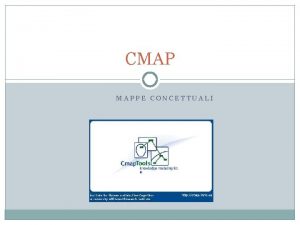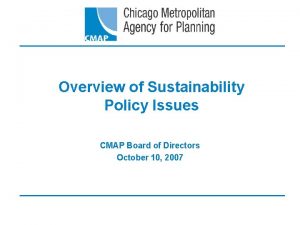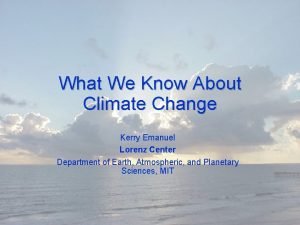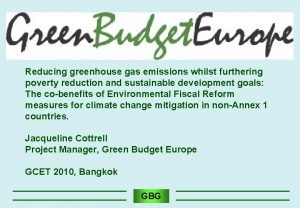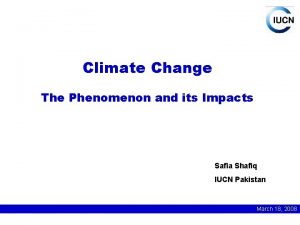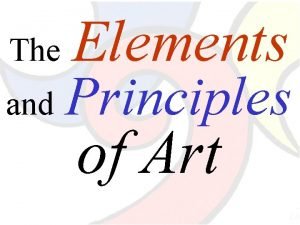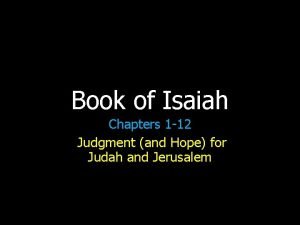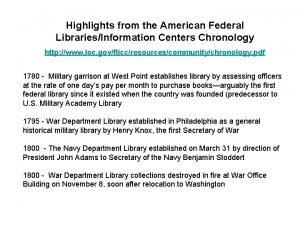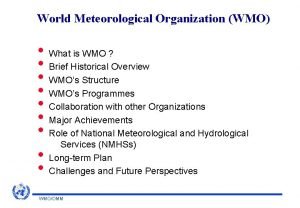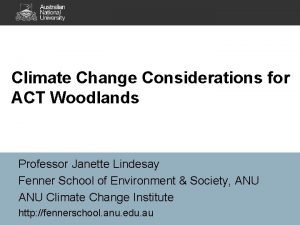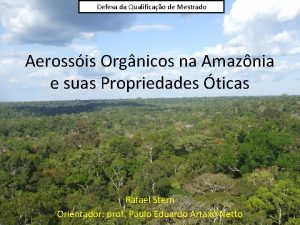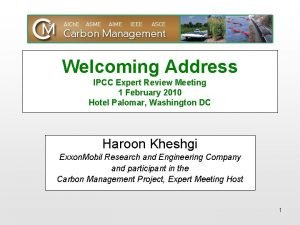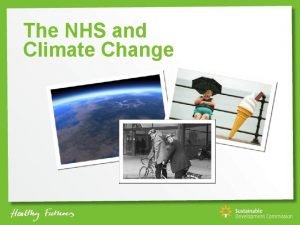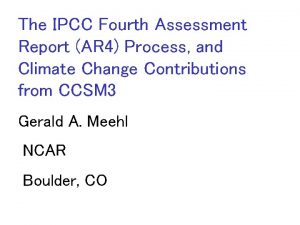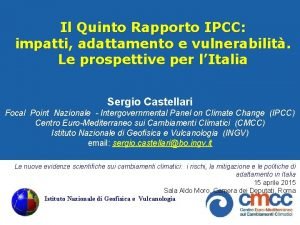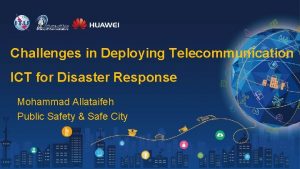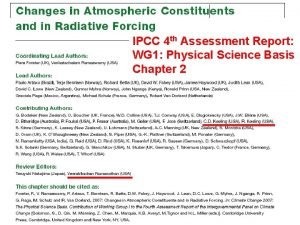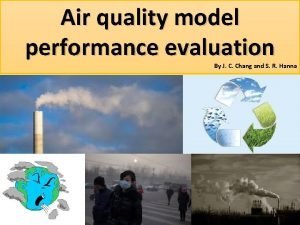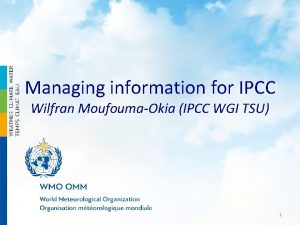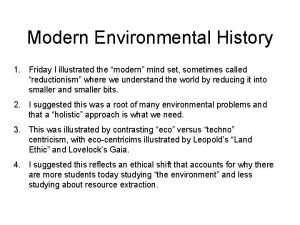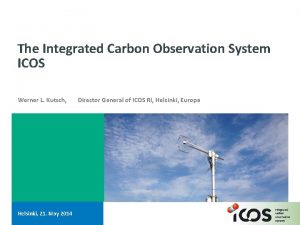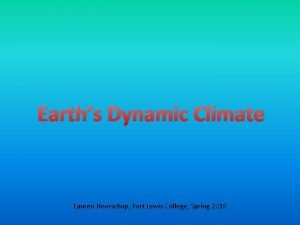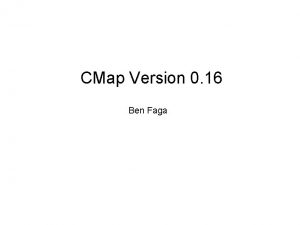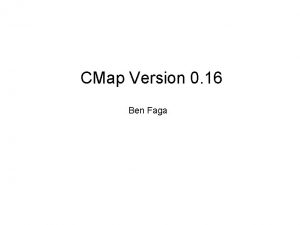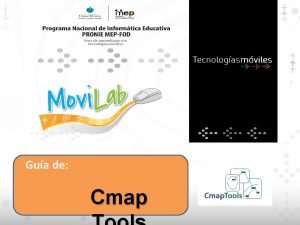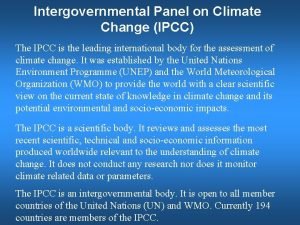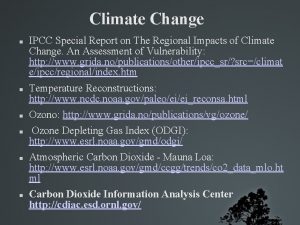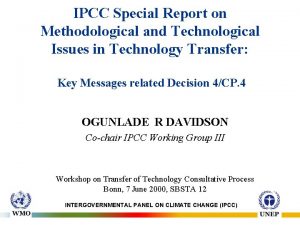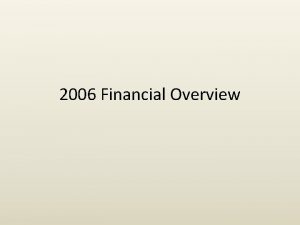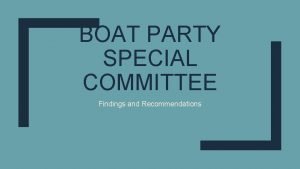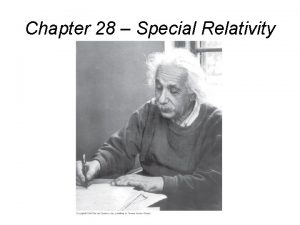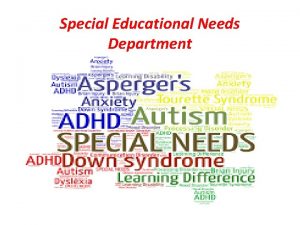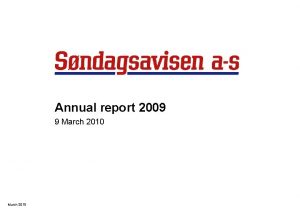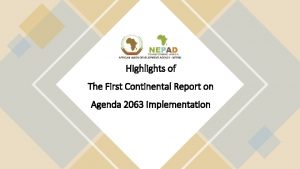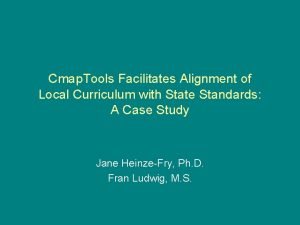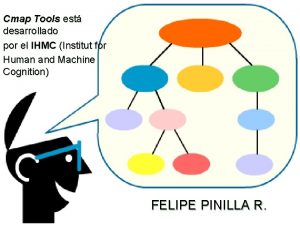Agenda IPCC Special Report Highlights IPCC Recommendations CMAP































- Slides: 31


Agenda �IPCC Special Report Highlights �IPCC Recommendations �CMAP Greenhouse Gas Report �Discussion Tying the 2 together Local groups & strategies

UN Sustainable Development Goals (SDG) �The UN has 17 Sustainable Development Goals Ø Universal Call to Action to end: � Poverty � Protect the planet � Ensure all people enjoy peace and prosperity �Unique in that they call on ALL countries �#13 – Climate Change �IPCC report is framed in the context of the SDGs

Who is the IPCC? The Intergovernmental Panel on Climate Change is an intergovernmental body of the United Nations, dedicated to providing the world with an objective, scientific view of climate change and its political and economic impacts.

Who is the IPCC? �They author the Climate Change Assessment Reports (5 so far) �These reports are used by all countries and form basis for the Paris Climate Accord �It represents over 30, 000 scientific publications

IPCC Special Report – Oct 2018 Report Main Themes �What would be required to limit warming to 1. 5° C �The impacts of 1. 5° C of warming, compared to 2° C and higher �Strengthening the global response to climate change, mitigation and adaptation options

Key Concepts �At present rates, we are likely to reach +1. 5° C between 2030 and 2052 (we are at +1° C already) � 2° C impacts worse than 1. 5° C in various ways across most natural and human systems § Mean temperature of land ocean regions Ø High latitudes: 4. 5° C @ 1. 5° C vs 6° C @ 2° C § Hot extremes (# of hot days) § Heavy precipitation (more frequent & more severe cyclones) § Probability of drought (more frequent & longer)

Key Concepts � 2° C impacts worse than 1. 5° C in various ways across most natural and human systems § Ocean level rise. 1 metre more at 2° C 10 million people additionally at more risk � Faster sea level rise provides less opportunities for adaptation � Somewhat unsure the level of marine ice sheet instability between 1. 5° C vs 2° C (Greenland & Antarctica) � § Specie loss � 16% vs 6% insects � 16% vs 8% plants � 8% vs 4% vertebrates § Land transformation from one ecosystem type to another � @1° C – 4% � @1. 5° C – 7% � @2° C – 13%

Key Concepts � 2° C impacts worse than 1. 5° C in various ways across most natural and human systems High Latitude Tundra/Permafrost loss � 1. 5 – 2. 5 million km 2 more Ocean Temperature � Sea ice free arctic once per decade vs once per century � Coral reef decline >99% vs 70 -90% � Greater ocean acidification � Decrease in annual fish catch 3 million tonnes vs 1. 5 million tonnes

Key Concepts � 2° C impacts worse than 1. 5° C in various ways across most natural and human systems Poverty � Several hundred million people Health � Heat related morbidity and mortality � Increase in certain diseases (malaria, dengue fever, etc. ) Food production � Smaller yields, loss of livestock, etc. Water Stress � Increase by 50%

Key Concepts � 2° C impacts worse than 1. 5° C in various ways across most natural and human systems Economic Growth � Less (excluding the costs of mitigation, adaptation as well as the benefits of adaptation) Conflict (my addition) � Over food, water, land, etc.

Key Concepts

Adaptation

Adaptation

Mitigation Goals & Strategies �For 1. 5° C: Emissions decline of 45% from 2010 levels by 2030 and net zero by 2050 �For 2° C: Emissions decline of 20% from 2010 levels by 2030 and net zero by 2075 �Portfolio of measures includes § § Lowering energy intensity Decarbonization CO 2 removal Non CO 2 emissions reduction of 35% or more

Mitigation Goals & Strategies �Energy (by 2050) § § § Lower use through efficiency measures Faster electrification of energy end use (e. g. vehicles) Greater share of low emission energy sources � Renewables 70 – 85% � Increase share of nuclear and fossil fuels with CCS With CCS, Gas share could be 8% � Coal 0%

Mitigation Goals & Strategies �Carbon Dioxide Removal (CDR) § § Afforestation & Reforestation Land Restoration Soil Carbon Sequestration New CDR Technology

The Challenge for People’s Hearts and Heads 45% reduction by 2030

The Challenge for People’s Hearts and Heads 45% reduction by 2030 3. 5% reduction by 2020

Is it an issue of perception? 45% reduction from 2010 levels by 2030 3. 5% reduction per year from previous year starting in 2010 until 2030

Where are we? Source: The Chicago Metropolitan Agency for Planning (CMAP)


If We Adopt IPCC Goal as Our Goal �Averaged 1. 4% reduction 2010 – 2015 �Need average 5. 5% reduction per year from previous year (assuming 2016 – 2018 same rate as 2015) Energy Efficiency Move to Clean Energy Electrify Transportation Plant Trees

How do we move the needle? � Communications � Collaborate/Cooperate � Education � Legislation Federal State Local � Political Engagement Elections Lobbying � Energy & Transportation Focus � Other Campaigns e. g. Reduce non-CO 2 emissions NWSOFA Sierra Club Faith in Place Citizens Climate Lobby League of Woman Voters Community Green Teams � � � � � Arlington Heights* Barrington Area** Buffalo Grove* Hoffman Estates** Palatine Park Ridge** Rolling Meadows* Schaumburg** Wheeling* * Signed Greenest Region Compact (GRC) ** plus Solsmart

Communications � Continue with our Group communications Expand reach � Establish more robust external communication tactics Letters to Editor Success Stories (PR) Space in Town’s newsletters Effective use of social media platforms Ø Establish a Group Communication Network Schedule a Summit/Workshop “It’s not too late to act”

Education/Events �Continue/Expand programs and events Share speakers �More focus to this subject/from different angles Adjust perceptions �Reach new audiences Research organizations outside of “Green” community

Legislative/Political �Federal Hold new elected officials accountable Seek opportunities to interact �State Follow IEC lead (FEJA 2. 0) Support new legislation/Lobby Ø Local Municipal Elections Leverage GRC Hold Summit/Workshop on GRC

Clean Energy/Transportation �Leverage GRC �Leverage Solsmart �Offer Solarize Program (Solar Group Buy) �Educate �Campaigns related to Transportation

Green Groups Collaboration �Communication �Events �Best Practices �Strategy GRC Solsmart

Next Steps? �Communications Summit/Workshop – Lead? �GRC Summit/Workshop – Lead? Palatine: - Get GRC approved Others: - Review GRC and refine appropriately Others w/ Solsmart: - Drive solar installation demand � ISEA Solar Ambassador Presentation � Develop a Solarize (Group Buy) program �What is your 2019 Plan? �Interest in “The Human Element” screening?

Contact Info Peter Gorr pagorr@comcast. net 847 -767 -0993 Sierra Club Illinois Solar Energy Association Go Green Barrington Deer Grove Natural Areas Volunteers
 Castlewood primary school
Castlewood primary school Cmap mappe concettuali
Cmap mappe concettuali Cmap board
Cmap board Ipcc 2007 report
Ipcc 2007 report Ipcc 2007 report
Ipcc 2007 report Ipcc report
Ipcc report Conclusion of yashpal committee report
Conclusion of yashpal committee report Agenda sistemica y agenda institucional
Agenda sistemica y agenda institucional Principles of arts
Principles of arts Key highlight icon
Key highlight icon Highlights from the book of isaiah
Highlights from the book of isaiah Proposal highlights
Proposal highlights Highlights from the book of isaiah
Highlights from the book of isaiah Highlights memorandum
Highlights memorandum The passage highlights……
The passage highlights…… Objective for work immersion
Objective for work immersion Investment highlights
Investment highlights Ipcc wmo
Ipcc wmo Ipcc
Ipcc Ipcc ar5
Ipcc ar5 Ipcc 2013
Ipcc 2013 Ipcc
Ipcc Ipcc 2001
Ipcc 2001 Ipcc
Ipcc Ipcc
Ipcc Huawei ipcc
Huawei ipcc Ipcc
Ipcc Ipcc 2013
Ipcc 2013 Wilfran moufouma-okia
Wilfran moufouma-okia Ipcc 2001
Ipcc 2001 Ipcc 2013
Ipcc 2013 Ipcc ppt
Ipcc ppt

